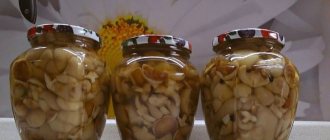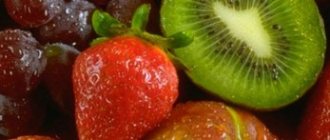Grape juice
- juice made from grapes. It serves as the basis for the production of wine and other drinks. Grape juice production waste is used to make various products. The juice contains glucose, fructose, organic acids, minerals, and amino acids. Grape juice is useful for a number of diseases and functional disorders[1].
Compound
Depending on the grape variety and climatic conditions in the place where it grows, the organoleptic properties and substance content in the juice can vary significantly. Grape juice contains glucose (how much?), fructose (how much?), organic acids (gallic, orotic, caffeic, ascorbic, chlorogenic, nicotinic), minerals, amino acids (proline, arginine, serine, tryptophan, alpha-alanine, methionine and etc.). During the production of grape juices obtained by pressing, fat-soluble vitamins, some macro- and microelements, and amino acids remain in the pomace and sediments. Also, some of the nutrients are lost during clarification and stabilization of the juice[2].
Harm of grape juice and contraindications
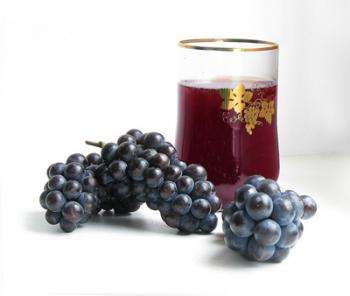
Grape juice can cause harm in cases of liver cirrhosis and obesity. People who suffer from urinary problems and are prone to flatulence should avoid the drink. This drink is strictly contraindicated in the diet of diabetics, as well as people suffering from heart defects, ulcers and gastritis.
Pregnant women should drink juice with caution.
It is worth considering that grape juice can damage enamel and affect the occurrence of caries, so it is recommended to drink it through a straw, and be sure to rinse your mouth after drinking.
Cooking recipes with photos
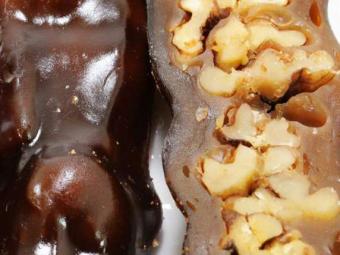
Churchkhela homemade
50 min.
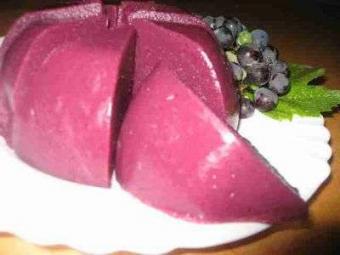
Pelamushi
30 min.
Similar food products
- Lemon juice
- Apricot juice
- Cherry juice
- Pomegranate juice
The nutritional value
| Alcohol | 0.2 g |
| Ash | 0.3 g |
| Mono- and disaccharides | 16.3 g |
| Water | 81.9 g |
| Organic acids | 0.5 g |
| Alimentary fiber | 0.3 g |
Vitamins
| Vitamin PP (Niacin Equivalent) | 0.1 mg |
| Vitamin E (alpha tocopherol) | 0.2 mg |
| Vitamin C (ascorbic acid) | 2 mg |
| Vitamin B2 (riboflavin) | 0.01 mg |
| Vitamin B1 (thiamine) | 0.02 mg |
| Vitamin B3 (PP) | 0.1 mg |
Production
At home
Making grape juice at home is not difficult. First, the grapes are washed and destemmed. To produce a small amount of juice, use a mechanical or electric juicer, meat grinder, blender or food processor. To obtain large quantities of grape juice, hand presses are used. The juice obtained from a press or electric juicer can be consumed immediately. In other cases, the juice from crushed berries or the resulting slurry should be drained using a sieve or gauze. Freshly squeezed juice does not last long. It can be preserved by heat treatment, pouring into sterilized containers and sealing (see canning). The juice should be stored refrigerated.
Industrial production
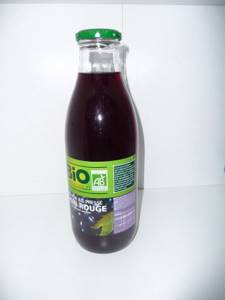
Plants for processing grapes into juice are usually located near vineyards. The harvested grapes are delivered to the workshops by trucks. First, the grapes are washed and sent to an inspection conveyor for quality control. At the next stage, the grape ridges are separated and the berries are fed into the crusher. The wort, obtained by gravity after grinding, enters the storage tank, and the pulp is sent under the press, after which the squeezed juice is also sent to the storage tank [3].
Subsequently, the collected liquid undergoes coarse filtration, clarified with flocculants (silicon dioxide and gelatin) and sent to a centrifuge. After this stage, it passes through a fine filter and cools. Next, the detartration process uses liquid carbon dioxide to separate the tartar and remove the sediment during filtration. At the last stages of processing, the grape juice is deaerated, sent for packaging and pasteurized[3].
Useful acids
Grape juice has a unique set of acids, the main of which are tartaric (rarely found in other juices) and L-malic. These organic acids aid the digestion process.
HARM: For diarrhea, peptic ulcers, liver cirrhosis, renal failure, as well as for patients with urinary disorders, grape juice is contraindicated .
Among the hydroxycinnamic acids in grape juice, caftaric acid predominates, which has antiviral, antibacterial and anti-inflammatory activity.
BENEFITS: Thanks to this, grape juice is good for coughs and removes fluid from the lungs. This alleviates the condition of patients with bronchitis, pleurisy, asthma and even the initial stage of tuberculosis.
Notes
- Mitrakova S.I.
[ej.kubagro.ru/2009/06/pdf/06.pdf Evaluation of grape varieties for juice production] // Scientific journal of KubSAU. - 2009. - No. 50. - Sosyura E. A., Burtsev B. V., Guguchkina T. I.
Functional drink based on grape juice // Bulletin of the AIC of Stavropol. - 2011. - No. 4. - P. 18-21. - ↑ 1 2 Tagirova P. R.
[cyberleninka.ru/article/n/tehnologicheskie-priemy-pererabotki-vinograda Technological methods for processing grapes] // Polythematic network electronic scientific journal of the Kuban State Agrarian University. - 2014. - No. 100. - P. 521-533.
Canned freshly squeezed grape juice: benefits and harms
There is an opinion that this method of preserving grape juice preserves the maximum amount of nutrients. Actually this is not true. Firstly, freshly squeezed juice is a perishable product in which oxidative processes literally begin immediately. And secondly, boiling and sterilization, which cannot be avoided in this case, destroy most of the vitamins and minerals.
To improve taste and extend shelf life, apple and grape juice is made. The benefits and harms of such a drink are identical to canned grape juice.
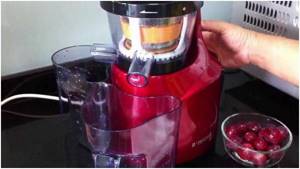
Excerpt characterizing Grape juice
- Well, what about the boy? - Is it spring? He collapsed there in the entryway. He sleeps with fear. I was really glad. For a long time after this, Petya was silent, listening to the sounds. Footsteps were heard in the darkness and a black figure appeared. -What are you sharpening? – the man asked, approaching the truck. - But sharpen the master’s saber. “Good job,” said the man who seemed to Petya to be a hussar. - Do you still have a cup? - And over there by the wheel. The hussar took the cup. “It’ll probably be light soon,” he said, yawning, and walked off somewhere. Petya should have known that he was in the forest, in Denisov’s party, a mile from the road, that he was sitting on a wagon captured from the French, around which the horses were tied, that the Cossack Likhachev was sitting under him and sharpening his saber, that there was a big black spot to the right is a guardhouse, and a bright red spot below to the left is a dying fire, that the man who came for a cup is a hussar who was thirsty; but he knew nothing and did not want to know it. He was in a magical kingdom in which there was nothing like reality. A large black spot, perhaps there was definitely a guardhouse, or perhaps there was a cave that led into the very depths of the earth. The red spot might have been fire, or maybe the eye of a huge monster. Maybe he’s definitely sitting on a wagon now, but it’s very possible that he’s not sitting on a wagon, but on a terribly high tower, from which if he fell, he’d fly to the ground for a whole day, a whole month - keep flying and never reach it . It may be that just a Cossack Likhachev is sitting under the truck, but it may very well be that this is the kindest, bravest, most wonderful, most excellent person in the world, whom no one knows. Maybe it was just a hussar passing for water and going into the ravine, or maybe he just disappeared from sight and completely disappeared, and he was not there. Whatever Petya saw now, nothing would surprise him. He was in a magical kingdom where everything was possible. He looked at the sky. And the sky was as magical as the earth. The sky was clearing, and clouds were moving quickly over the tops of the trees, as if revealing the stars. Sometimes it seemed that the sky cleared and a black, clear sky appeared. Sometimes it seemed that these black spots were clouds. Sometimes it seemed as if the sky was rising high, high above your head; sometimes the sky dropped completely, so that you could reach it with your hand. Petya began to close his eyes and sway. Drops fell. There was a quiet conversation. The horses neighed and fought. Someone was snoring. “Ozhig, zhig, zhig, zhig...” the saber being sharpened whistled. And suddenly Petya heard a harmonious choir of music playing some unknown, solemnly sweet hymn. Petya was musical, just like Natasha, and more than Nikolai, but he had never studied music, did not think about music, and therefore the motives that unexpectedly came to his mind were especially new and attractive to him. The music played louder and louder. The melody grew, moving from one instrument to another. What was called a fugue was happening, although Petya had not the slightest idea what a fugue was. Each instrument, sometimes similar to a violin, sometimes like trumpets - but better and cleaner than violins and trumpets - each instrument played its own and, not yet finishing the tune, merged with another, which started almost the same, and with the third, and with the fourth , and they all merged into one and scattered again, and again merged, now into the solemn church, now into the brightly brilliant and victorious. “Oh, yes, it’s me in a dream,” Petya said to himself, swaying forward. - It's in my ears. Or maybe it's my music. Well, again. Go ahead my music! Well!..” He closed his eyes. And from different sides, as if from afar, sounds began to tremble, began to harmonize, scatter, merge, and again everything united into the same sweet and solemn hymn. “Oh, what a delight this is! As much as I want and how I want,” Petya said to himself. He tried to lead this huge choir of instruments. “Well, hush, hush, freeze now. – And the sounds obeyed him. - Well, now it’s fuller, more fun. More, even more joyful. – And from an unknown depth arose intensifying, solemn sounds. “Well, voices, pester!” - Petya ordered. And first, male voices were heard from afar, then female voices. The voices grew, grew in uniform, solemn effort. Petya was scared and joyful to listen to their extraordinary beauty.
Composition of grape juice
So, grape juice is one of the most important and most nutritionally and dietaryly valuable products produced by the canning and wine industries. It is, as it should be, made from the best grape varieties capable of the highest accumulation of sugar while preserving all other components.
Grape juice is a product of technically mature grapes, selected for processing without rotten or damaged berries. It is not called natural for nothing.
The high calorie content and dietary benefits of grape juice are associated with a significant (up to 20%) content of sugars that are easily and completely digestible by the body - glucose and fructose. Based on the sugar content alone, the calorie content of a kilogram of grape juice is estimated by biologists to be between 480 and 1280 calories.
Increasing the consumption of grape juice, as well as increasing the consumption of other non-alcoholic drinks, leads to a significant improvement in population health and especially contributes to the development of children.
The experience of a number of countries, for example Switzerland, has shown that the increased use of soft drinks, especially grape juice, in food in recent years has led to a decrease in alcohol consumption by the population by almost half.
One cannot ignore the fact that a significant amount of pasteurized grape juice, in addition to state enterprises, is produced by private firms, as well as by the population itself.
As already mentioned, the main sugars in grape juice - glucose and fructose - are absorbed by the body directly, without the need for prior inversion. This property of glucose and fructose attracts the constant attention of doctors of various specialties and serves as an important factor in the widespread use of grape juice in medical practice.
Biologically active substances, primarily vitamins, are of particular importance in grape juice.
And if in grape wine, as a result of the vital activity of yeast, the amount of vitamins is significantly reduced, and some of them, such as thiamine, completely disappear, then in grape juice they are preserved almost completely due to their thermal stability.
As for vitamin C, there is much less of it in grapes than in other fruits, and during the processing of grapes, as a result of oxidative processes, vitamin C is partially destroyed.
High P-vitamin activity of grape tannins has been established. It is known that in the absence of vitamin P in the human body there is increased fragility of capillary vessels. In terms of the content of this vitamin, grapes occupy one of the first places among fruits and vegetables. The daily human need for vitamin P is approximately 300 I.E. This norm can be provided by 300-500 g of grapes.
Despite the presence of a wide variety of amino acids in grape juice, the total content of nitrogenous substances is low, which makes it the only food product recommended for patients requiring a hyponitrogen regime.
Of the mineral substances in grape juice, potassium and phosphoric acid predominate, followed by calcium, sodium, magnesium, iron, sulfur, and chlorine. The content of minerals so necessary for the body in grape juice is several hundred and tens of milligrams per liter.
However, they can hardly compete in their effect on the human body with microelements, which, along with the properties of biologically active substances, play the role of catalysts. The trace elements found include manganese, silicon, copper, zinc, aluminum, boron, iodine, bromine, fluorine, molybdenum, vanadium, titanium, rubidium, strontium, barium, tin, lead, arsenic and radium.
Their content varies widely from several milligrams to tenths, hundredths, etc. of milligrams - and depends primarily on the soil conditions for growing grapes. Thus, according to K.S. Popov, there is 20 times more manganese in the berries of Georgian grape varieties than in grapes from Kyrgyzstan. The vanadium content in black Pinot berries from Moldova is 30 times higher than in berries of the same variety, but grown in the North Caucasus.
Grape juices are sterile and partially satisfy the body's need for water.
The pH of grape juice (from 2.6 to 3.3) is close to the pH of gastric juice (2-2.5). This pH ratio allows grape juice to be widely used in clinical practice for gastric diseases, and the high content of glucose and fructose for heart diseases and heart failure, diseases of the nervous system and in cases of metabolic disorders.
The simplest and most common method of preserving grape juice for future use, that is, preventing fermentation of the must, is its pasteurization. The technology for preparing grape juice is mainly based on the following principle.
In the wine industry, gravity-fed wort, and in canning and press wort, is pasteurized to a temperature of 85° in order to kill the bacteria present in it. In this case, along with the killing of yeast organisms, a number of undesirable processes take place - the coagulation of proteins, pectin and other substances that precipitate.
To give grape juice a marketable appearance and remove sediment, it is subjected to filtration and re-pasteurization in glass or any other retail container. Clarification of grape juice prepared by pasteurization is extremely slow, and the resulting grape juice differs significantly from the source material - grape must, both in the content of biologically active substances and vitamins, and in taste - it has tones of boiling.
In recent years, in countries with powerful refrigeration facilities, stainless steel containers, etc., a new technology for preparing grape juice has been developed by cooling and storing the semi-finished product (must) in tanks or steel tanks made of stainless steel at low temperatures ( + 1.—3°). At the same time, the main components of the grape must are preserved in the grape juice.
After clarification, the grape juice stored in cooled containers is pasteurized before sale.
Somewhat different from the indicated technology for preparing grape juice is a new two-stage method based on sulfitation-desulfitation. It allows you to avoid heat treatment of semi-finished juice in refrigerated rooms with metal tanks.
Semi-finished juices prepared using sulfurous acid are subjected to filtration after storage, desulphitation on vacuum devices in canning shops and secondary filtration before bottling and bottle pasteurization.
The residual content of sulfur dioxide in a bound state in juices is 0.0001-0.003%; free - not contained.
The juice has a beautiful color, freshness, grape aroma, and is easy to drink. More of such a wonderful drink!
The use of relatively new preservatives - sorbic acid and diethyl pyrocarbonic acid - opens up great prospects in juice production.
Treatment of diseases with grapevines
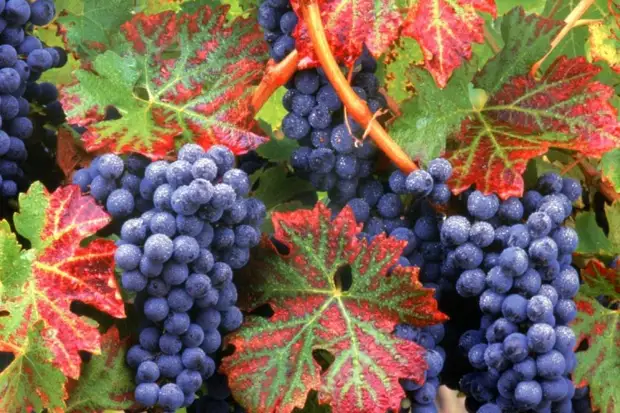
Grapevine or grapes are a perennial climbing plant with juicy, tasty berries. Treatment of diseases with grapevines has been known since ancient times. All parts of grapes are used for medicinal purposes: fruits, wood, roots, leaves, tendrils, young shoots, tears. It is believed that wild grapes have the best medicinal properties. Although many healers use cultivated varieties of grapevines to treat diseases.
The teardrop of the vine or tree sap that appears on the trunk and shoots of the plant reduces small warts. Fresh tears taken from young shoots of the vine are mixed in equal proportions with olive oil and applied to the skin to remove hair. After 3-5 minutes, you need to rub your hand over the areas of the body lubricated with the composition. Ringworms are also lubricated with tears.
For muscle ruptures and weakened joints, use grapevine ash mixed with olive oil. To do this, they burn the dried shoots and trunk of the grapes, and then sift the ash through a sieve. To prepare the patch, take 2 tbsp. ash and 1 tablespoon of oil, grind until smooth and apply to fabric. The patch is applied to the sore spot, secured and kept for 6-8 hours.
For bruises from a fall, drink a water infusion of ash: 1 tsp.
l. ash per 1 glass of water. Leave for 30 minutes, strain. Drink 0.5 cups 2 times a day.
To treat headaches, a medicinal bandage is made from tendrils and grape leaves. First, the raw materials need to be crushed a little in a mortar, and then the mass is evenly distributed on the fabric. Keep the bandage on for 2-3 hours.
Grapevine bark mixed with honey is used to treat gum disease. The bark is pounded in a mortar until it becomes flour, sifted through a sieve and mixed with honey 1:1. The medicine is applied to the gums 6-8 times a day.
For swollen, watery eyes, make a lotion from barley oatmeal and grapevine leaves. Rub the washed grape leaf a little in the palm of your hand until the juice appears. Then a little oatmeal is applied to it and applied to the eye. Keep the lotion for 15-20 minutes.
For hemoptysis, take 0.5 cups 3 times a day, a mixture of squeezed juice from leaves and grape berries. For 1 part leaf juice, take 2 parts berry juice.
For stomach diseases, to relieve inflammation, make a compress on the stomach area from crushed leaves, grapevine tendrils and barley oatmeal.
To treat stomach pain and heartburn, drink juice from grape leaves, 1-2 tbsp. 3-4 times a day.
In case of increased acidity, nausea, anxiety, it is recommended to eat grapes (100-150 g) in the daytime, 2 hours before or after meals.
For dysentery and irritation in the anus caused by frequent bowel movements, you need to drink 2 tablespoons of grapevine leaf juice. every 2 hours.
For urolithiasis, grapevine tears are mixed with wine: 1 part tears to 3 parts dry wine. Take 1 tbsp. 3 times a day.
Ancient doctors believed that the ash of dried grapevines was an excellent antidote against viper bites.
For uterine bleeding, take 1 tsp orally. powder from dried grape leaves.
In case of large blood loss, weakness after an illness, nervous fatigue, insomnia, give compote from dried or fresh grapes to drink.
A decoction of dried grapes and onion juice is used to treat laryngitis and dry cough.
For high fever, tonsillitis, pharyngitis, and mouth ulcers, give one-third of a glass of unripe grape juice 3-4 times a day.
For hypertension, headaches, and general weakness, use an infusion of dry young grape leaves. 1 tbsp. crushed medicinal raw materials are brewed with 1 cup of boiling water. Leave for 20 minutes and take 0.5 cups 3-4 times a day before meals.
Unripe berries are rubbed onto the face to give it freshness, elasticity and softness. The juice of unripe berries is used in cosmetics for compresses, toning and improving complexion. To do this, moisten a thin layer of cotton wool in the juice and cover the face, neck and décolleté with it. The procedure time is 15-20 minutes. Afterwards, the skin must be washed, blotted with a soft cloth, and then lubricated with a light nourishing cream or grape seed oil.
It must be remembered that grape fruits irritate the bladder, so it is not recommended to eat them if you have urinary incontinence, cystitis, or inflammation of the bladder. During treatment with grape fruits, it is forbidden to eat raw milk, fatty meat, kvass, carbonated and mineral drinks. People with diabetes, peptic ulcers, colitis and people who are obese should not eat grapes. After eating fresh or dried grapes, you should brush your teeth or rinse your mouth with water.







